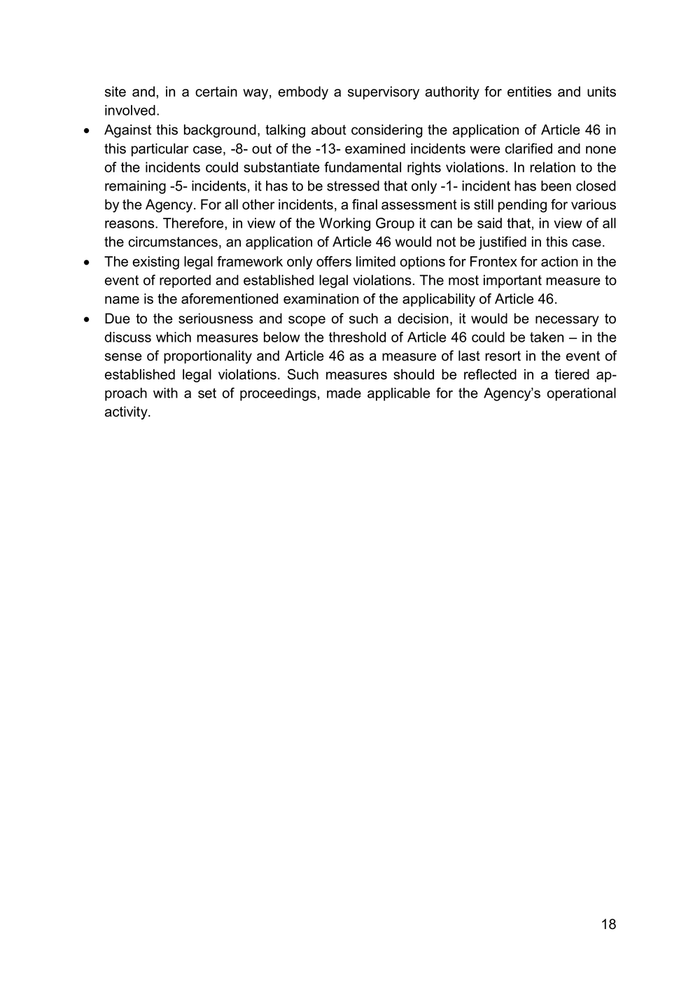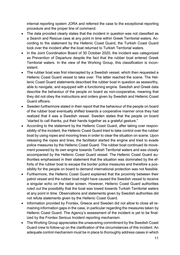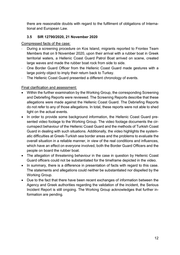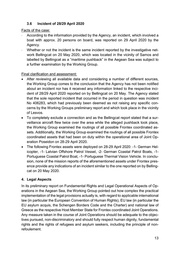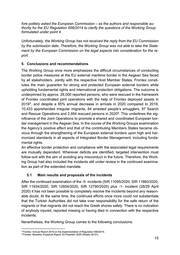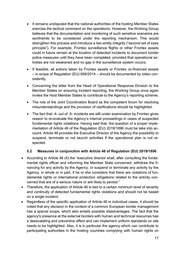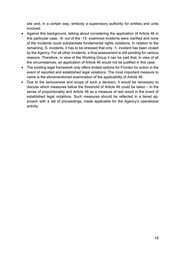Fundamental Rights and Legal Operational Aspects of Operations in the Aegean Sea
Final Report of the Frontex Management Board Working Group
internal reporting system JORA and referred the case to the exceptional reporting procedure and the proper line of command. • The data provided clearly states that the incident in question was not classified as a Search and Rescue case at any point in time within Greek Territorial waters. Ac- cording to the statement by the Hellenic Coast Guard, the Turkish Coast Guard took over the incident after the boat returned to Turkish Territorial waters. • In the Joint Coordination Board of 30 October 2020, the incident was categorized as Prevention of Departure despite the fact that the rubber boat entered Greek Territorial waters. In the view of the Working Group, this classification is incon- sistent. • The rubber boat was first intercepted by a Swedish vessel, which then requested a Hellenic Coast Guard vessel to take over. The latter reached the scene. The Hel- lenic Coast Guard statements described the rubber boat in question as seaworthy, able to navigate, and equipped with a functioning engine. Swedish and Greek data describe the behaviour of the people on board as non-cooperative, meaning that they did not obey the instructions and orders given by Swedish and Hellenic Coast Guard officers. • Sweden furthermore stated in their report that the behaviour of the people on board of the rubber boat eventually shifted towards a cooperative manner once they had realized that it was a Swedish vessel. Sweden states that the people on board “started to call thanks, put their hands together as a grateful gesture.” • According to the statement by the Hellenic Coast Guard, after taking over respon- sibility of the incident, the Hellenic Coast Guard tried to take control over the rubber boat by using ropes and mooring lines in order to clear the situation on scene. Upon releasing the ropes and lines, the facilitator started the engine and tried to evade police measures by the Hellenic Coast Guard. The rubber boat continued its move- ment powered by its own engine towards Turkish Territorial waters and was closely accompanied by the Hellenic Coast Guard vessel. The Hellenic Coast Guard au- thorities emphasised in their statement that the situation was dominated by the ef- forts of the rubber boat to escape the border police measures and therefore a pos- sibility for the people on board to demand international protection was not feasible. • Furthermore, the Hellenic Coast Guard explained that the proximity between their patrol vessel and the rubber boat might have caused the Swedish vessel to receive a singular echo on the radar screen. However, Hellenic Coast Guard authorities ruled out the possibility that the boat was towed towards Turkish Territorial waters at any point in time. Observations and statements given by Swedish authorities did not refute statements given by the Hellenic Coast Guard. • Information provided by Frontex, Greece and Sweden did not allow to close all re- maining information gaps in the case, in particular regarding the measures taken by Hellenic Coast Guard. The Agency’s assessment of the incident is yet to be final- ized by the Frontex Serious Incident reporting mechanism. • The Working Group appreciates the unwavering commitment by the Swedish Coast Guard crew to follow-up on the clarification of the circumstances of this incident. An adequate control mechanism must be in place to thoroughly address cases in which 11
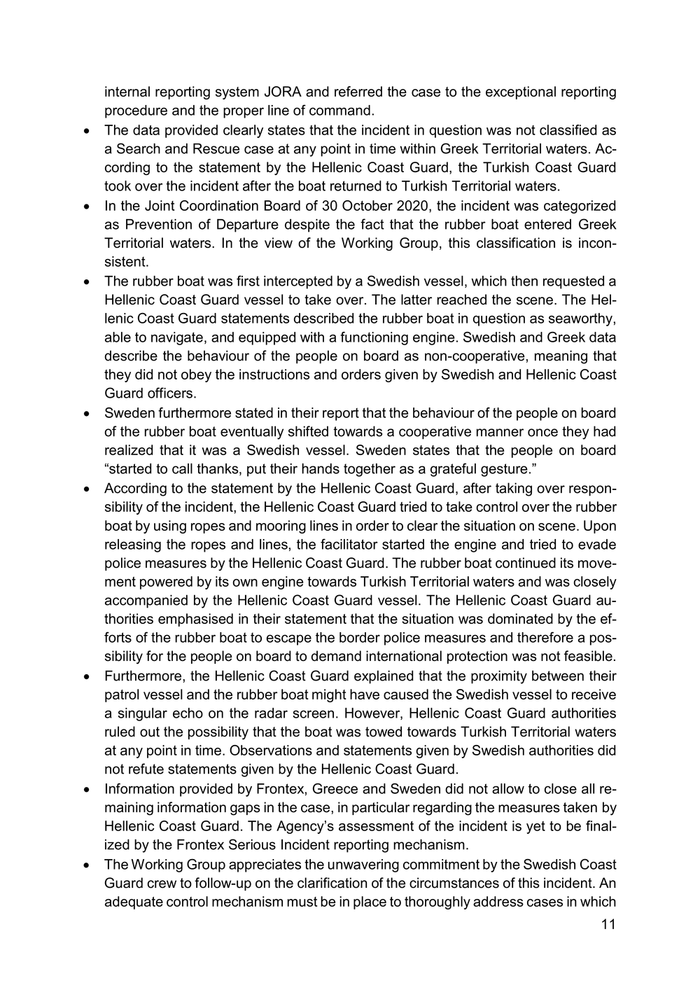
there are reasonable doubts with regard to the fulfilment of obligations of Interna- tional and European Law. 3.5 SIR 12790/2020, 21 November 2020 Compressed facts of the case: ⋅ During a screening procedure on Kos Island, migrants reported to Frontex Team Members that on 9 November 2020, upon their arrival with a rubber boat in Greek territorial waters, a Hellenic Coast Guard Patrol Boat arrived on scene, created large waves and made the rubber boat rock from side to side. ⋅ One Border Guard Officer from the Hellenic Coast Guard made gestures with a large pointy object to imply their return back to Turkey. ⋅ The Hellenic Coast Guard presented a different chronology of events. Final clarification and assessment: • Within the further examination by the Working Group, the corresponding Screening and Debriefing Reports were reviewed. The Screening Reports describe that these allegations were made against the Hellenic Coast Guard. The Debriefing Reports do not refer to any of those allegations. In total, these reports were not able to shed light on the actual events. • In order to provide some background information, the Hellenic Coast Guard pre- sented video footage to the Working Group. The video footage documents the cir- cumspect behaviour of the Hellenic Coast Guard and the methods of Turkish Coast Guard in dealing with such situations. Additionally, the video highlights the system- atic difficulties at Greek-Turkish sea border areas and the problems to evaluate the overall situation in a reliable manner, in view of the real conditions and influences, which have an effect on everyone involved, both the Border Guard Officers and the people on board the rubber boat. • The allegation of threatening behaviour in the case in question by Hellenic Coast Guard officers could not be substantiated for the timeframe depicted in the video. • In summary, there is a difference in presentation of facts with regard to this case. The statements and allegations could neither be substantiated nor dispelled by the Working Group. • Due to the fact that there have been recent exchanges of information between the Agency and Greek authorities regarding the validation of the incident, the Serious Incident Report is still ongoing. The Working Group acknowledges that further in- formation are pending. 12
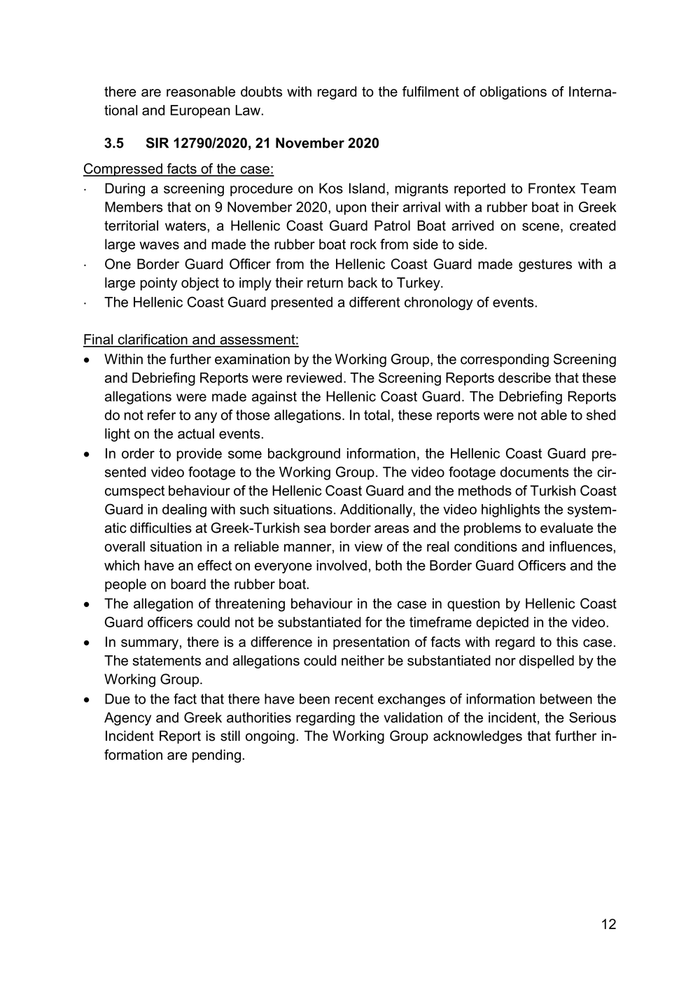
3.6 Incident of 28/29 April 2020 Facts of the case: ⋅ According to the information provided by the Agency, an incident, which involved a boat with approx. 20 persons on board, was reported on 29 April 2020 by the Agency. ⋅ Whether or not the incident is the same incident reported by the investigative net- work Bellingcat on 20 May 2020, which was located in the vicinity of Samos and labelled by Bellingcat as a “maritime pushback” in the Aegean Sea was subject to a further examination by the Working Group. Final clarification and assessment: • After reviewing all available data and considering a number of different sources, the Working Group comes to the conclusion that the Agency has not been notified about an incident nor has it received any information linked to the respective inci- dent of 28/29 April 2020 reported on by Bellingcat on 20 May. The Agency stated that the sole reported incident that occurred in the period in question was incident No 406283, which had previously been deemed as not raising any specific con- cerns by the Working Groups preliminary report and which took place in the vicinity of Lesvos. • To completely exclude a connection and as the Bellingcat report stated that a sur- veillance aircraft flew twice over the area while the alleged pushback took place, the Working Group examined the routings of all possible Frontex coordinated as- sets. Additionally, the Working Group examined the routings of all possible Frontex coordinated assets that had been on duty within the operational area of Joint Op- eration Poseidon on 28-29 April 2020. • The following Frontex assets were deployed on 28-29 April 2020: -1- German Hel- icopter, -1- Latvian Offshore Patrol Vessel, -2- German Coastal Patrol Boats, -1- Portuguese Coastal Patrol Boat, -1- Portuguese Thermal Vision Vehicle. In conclu- sion, none of the mission reports of the aforementioned assets under Frontex pres- ence provide any indications of an incident similar to the one reported on by Belling- cat on 20 May 2020. 4. Legal Aspects In its preliminary report on Fundamental Rights and Legal Operational Aspects of Op- erations in the Aegean Sea, the Working Group pointed out how complex the practical implementation of the legal provisions actually is, with regard to applicable international law (in particular the European Convention of Human Rights), EU law (in particular the EU asylum acquis, the Schengen Borders Code and the Charter) and national law of Greece as the respective Host Member State for Frontex coordinated Joint Operations. Any measure taken in the course of Joint Operations should be adequate to the objec- tives pursued, non-discriminatory and should fully respect human dignity, fundamental rights and the rights of refugees and asylum seekers, including the principle of non- refoulement. 13
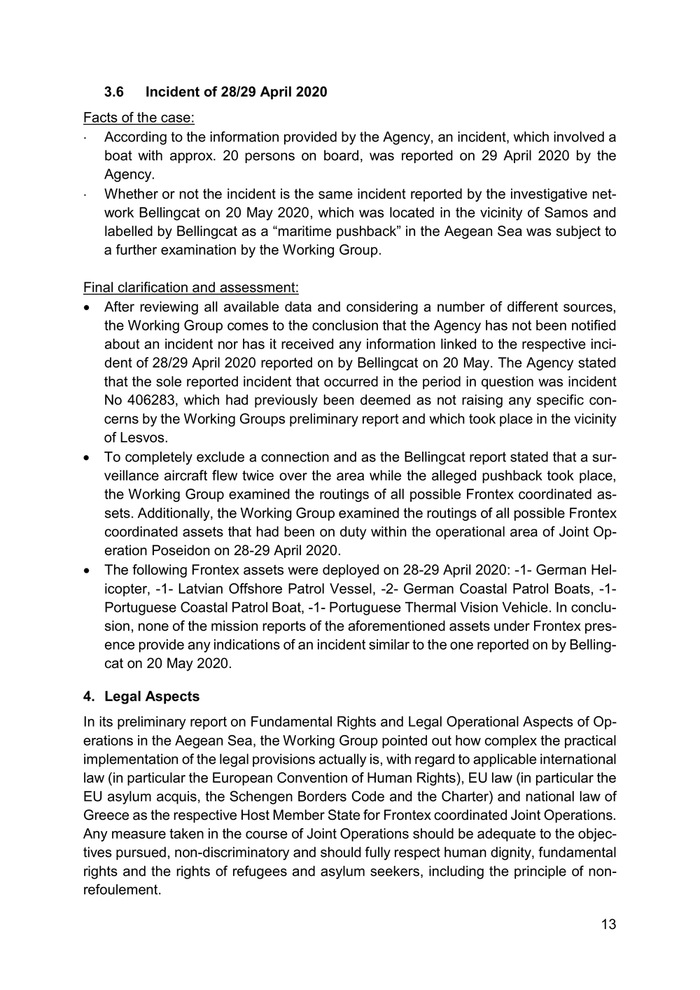
However, this Working Group fully acknowledges the special circumstances at the Greek/Turkish maritime border (without high seas) – such as factors at sea, individual behaviour of facilitators/offenders and hybrid threats – affecting actions of responsible 3 officers in each individual case. The Working Group believes that guidance is needed in order to come to a conclusion for reconciling the following legal provisions: the European Court of Human Rights (ECHR) judgment in the case N.D and N.T of 13 February 2020; Regulation (EU) 656/2014; special circumstances following the agreement between the EU and Turkey 4 (on the readmission of persons residing without authorization) from 2014 and the EU- Turkey statement from 2016. This Working Group asked the European Commission to elaborate on the practical implementation of applicable law if facts lead to the assumption of a detected illegal border crossing attempt into (sea) territory of a European Union Member State (not a distress situation). Guidance is needed on possible circumstances at sea borders, un- der which migrants can be immediately returned to a third country without individual assessment. It needs to be clarified, to what extent the key messages of the 13 February 2020 N.D and N.T judgment (ECtHR applications 8675/15 and 8697/15), regarding the possible return of migrants directly to (safe or not safe) a third country without an individual assessment, can be applied at the maritime borders in light of Art. 6 of EU Regulation 656/2014, taking into account international and EU fundamental rights obligations. The need for ensuring common rules for land and sea borders should also be taken into account. • Against the background of this new jurisprudence, the Working Group politely asked the European Commission to clarify under which conditions article 6 §2 b) of Regulation 656/2014 can be applied without infringing article 4 §3? • To what extent are the provisions and formal requirements for a refusal of entry (as stated in Art.14 (i.e. Annex V) Schengen Border Code or under national law) appli- cable during measures taken according to Art. 6 of Regulation (EU) 656/2014? The aim of this consultation is to provide the basis for issuing clear operating instruc- tions for practical use for the Team Members in Frontex operational activities. As already stated in the preliminary report – and mentioned in the conclusions of the Management Board on 21 January 2021 – it needs to be clarified, to what extent the key messages of the 13 February 2020 N.D and N.T judgment (ECtHR applications 8675/15 and 8697/15), regarding the possible return of migrants directly to (safe or not safe) a third country without an individual assessment, can be applied at the mari- time borders in light of Art. 6 of EU Regulation 656/2014. The Working Group there- 3 As indicated by Frontex strategic risk analysis as well as pandemic and connected EU travel restrictions. 4 The agreement between the EU and Turkey on the readmission of persons residing without authorization) from 2014 and the EU-Turkey statement from 2016. 14
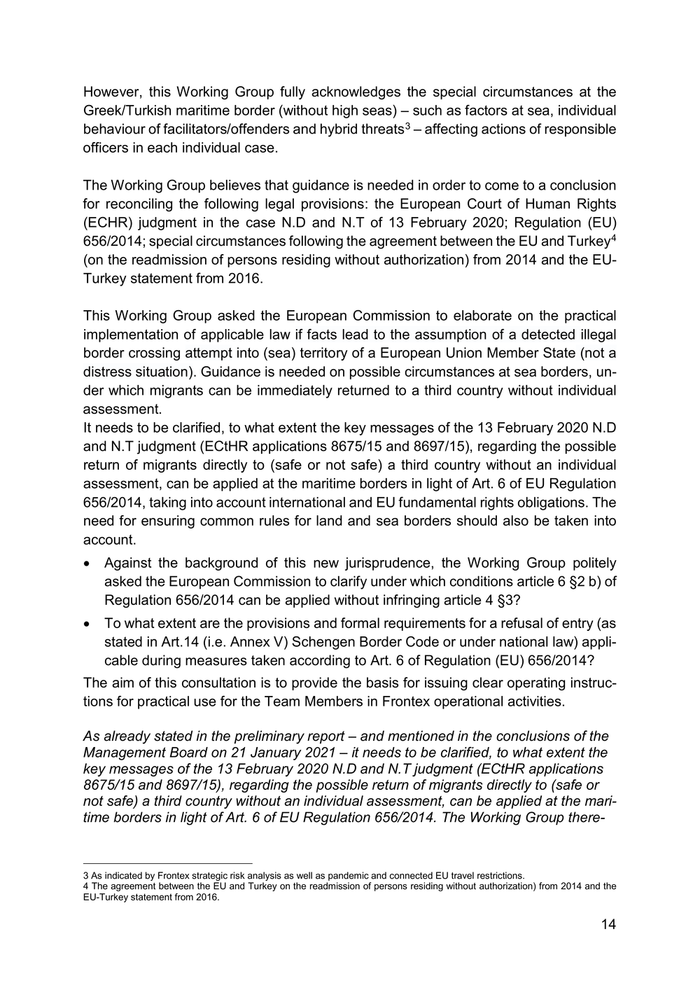
fore politely asked the European Commission – as the authors and responsible au- thority for the EU Regulation 656/2014 to clarify the questions of the Working Group formulated under point 4. Unfortunately, the Working Group has not received the reply from the EU Commission by the submission date. Therefore, the Working Group was not able to take the State- ment by the European Commission on the legal aspects into consideration for the re- port. 5. Conclusions and recommendations The Working Group once more emphasizes the difficult circumstances of conducting border police measures at the EU external maritime border in the Aegean Sea faced by all stakeholders. Jointly with the respective Host Member States, Frontex consti- tutes the main guarantor for strong and protected European external borders while upholding fundamental rights and international protection obligations. The outcome is underpinned by approx. 28,000 reported persons, who were rescued in the framework of Frontex coordinated joint operations with the help of Frontex deployed assets in 2019 . and despite a 85% annual decrease in arrivals in 2020 compared to 2019, 5 10,433 apprehended irregular migrants, 84 arrested people’s smugglers, 97 Search and Rescue Operations and 2,954 rescued persons in 2020 . This underlines the sig- 6 nificance of the Joint Operations to promote a shared and coordinated European bor- der management in the Aegean Sea. In the course of the Working Groups examination the Agency’s positive effect and that of the contributing Members States became ob- vious through the strengthening of the European external borders upon high and har- monized standards in all aspects of Integrated Border Management, including funda- mental rights. An effective border protection and compliance with the associated legal requirements are mutually dependent. Wherever deficits are identified, targeted intervention must follow-suit with the aim of avoiding any misconduct in the future. Therefore, the Work- ing Group had also included the incidents still under review in the continued examina- tion as part of the extended mandate. 5.1 Main results and proposals of the incidents After the continued examination of the -5- incidents (SIR 11095/2020, SIR 11860/2020, SIR 11934/2020, SIR 12604/2020, SIR 12790/2020) plus -1- incident (28/29 April 2020) it has not been possible to completely resolve the incidents beyond any reason- able doubt. At the same time, the continued efforts once more could not substantiate that the Turkish Authorities did not take over responsibility for the safe return of the migrants or that migrants did not reach the Greek shores safely. There is no indication of anybody injured, reported missing or having died in connection with the respective incidents. Nevertheless, the Working Group comes to the following conclusions: 5 Frontex: Annual Report 2019 on the implementation of Regulation 656/2014. 6 Frontex: Biweekly Analytical Report JO Poseidon 2020 (Weeks 50-51). 15
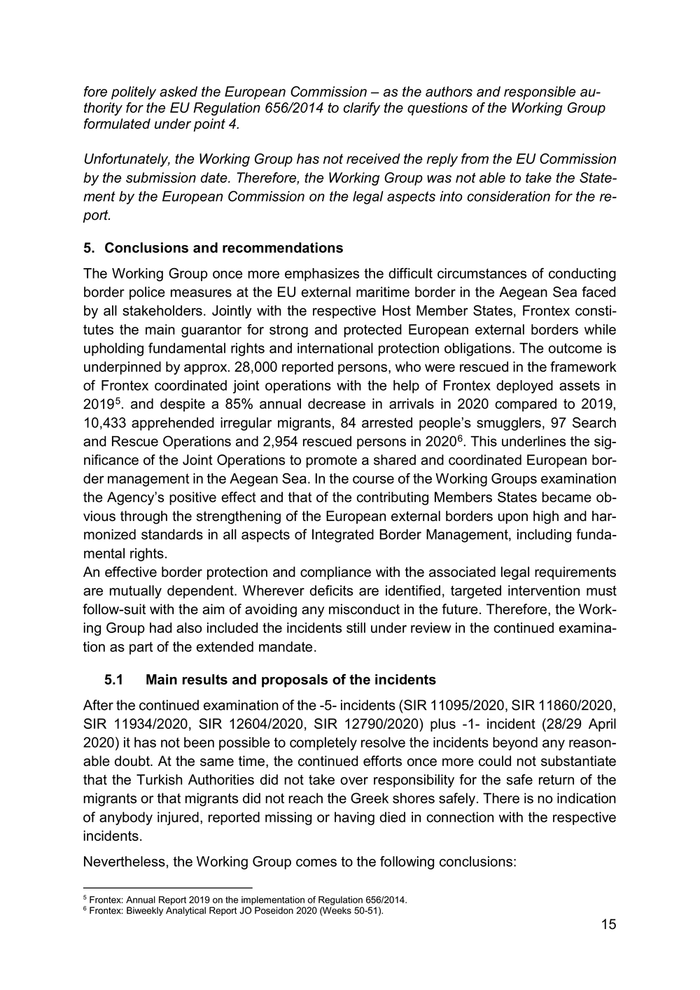
• Not every detected attempt of illegal border crossing by circumventing official Border Crossing Points – not even at sea – can automatically be considered as an asylum case. However, the right of access to asylum must be guaranteed regardless of the circumstances. The EU Member States have agreed on a common European asylum policy, including subsidiary and temporary protec- tion. Article 4 of EU Regulation 656/2014 also underlines this right once again and points out that any measures under this Regulation may only be taken in accordance with this fundamental right. Especially this aspect has also been stressed by the Consultative Forum in their letter to the Working Group and the Chair of the Management Board. 7 • Boats must not be left adrift unable to navigate regardless of other vessels in the vicinity. All stakeholders shall undertake the utmost to prevent such situa- tions at any given time as well as any interference to the sea-worthiness to ves- sels at sea. This aspect has also been highlighted by the Consultative Forum in their letter to the Working Group and the Chair of the Management Board. 8 • Any incident implying a possible violation of fundamental rights must be cate- gorized in a Serious Incident Report category 4 and immediately allocated to the coordination of the Agency’s Fundamental Rights Officer (or equivalent in a new system). Corresponding investigative measures must be carried out with- out any delay and finalized as soon as possible. Any retrograde interference to adjust operational data shall be avoided. Necessary measures by all parties shall be taken into consideration to prevent even the slightest indication of such behaviour in the future. • The deficits and the need for improvement of the reporting and monitoring sys- tem have already been described in the preliminary report. These shortcomings lead (inter alia) to the outcome that the Working Group was not able to clarify completely the five further examined incidents. • The Working Group welcomes that, based on the conclusions of the Manage- ment Board of 21 January 2021, the Agency has already undertaken efforts and actions to reform its reporting and monitoring mechanism, and has presented the intermediate results on 10 February 2021. It also welcomes the letter from the Head of Frontex’s Operational Response Division to the Member States on ensuring incident reporting as well as the roadmap to include the proposed rec- ommendations. Acknowledging the recommendations already included in the Management Board con- clusions of 21 January 2021 referring to the preliminary report, the Working Group makes the following additional recommendations: 7 See the letter of Consultative Forum to the Chair of the Frontex Management Board from 24 February 2021. 8 See the letter of Consultative Forum to the Chair of the Frontex Management Board from 24 February 2021. 16

• It remains undisputed that the national authorities of the hosting Member States exercise the tactical command on the operations. However, the Working Group believes that the documentation and monitoring of such sensitive scenarios are worthwhile to be considered under the reporting mechanism. This would strengthen this process and introduce a two-entity integrity (“second set of eyes principle”). For example, Frontex surveillance flights or other Frontex assets could in future remain at the location of detected incidents to document border police measures until they have been completed, provided that operational ac- tivities are not weakened and no gap in the surveillance system occurs. • If feasible, all actions taken by Frontex assets or Frontex co-financed assets – in scope of Regulation (EU) 656/2014 – should be documented by video con- sistently. • Concerning the letter from the Head of Operational Response Division to the Member States on ensuring incident reporting, the Working Group once again invites the Host Member States to contribute to the Agency’s reporting scheme. • The role of the Joint Coordination Board as the competent forum for resolving misunderstandings and the provision of clarifications should be highlighted. • The fact that -4- out of -5- incidents are still under examination by Frontex gives reason to re-evaluate the Agency’s internal proceedings in cases of suspected fundamental rights violations. Having said that, the question of a proper imple- mentation of Article 46 of the Regulation (EU) 2019/1896 must be take into ac- count. Article 46 provides the Executive Director of the Agency the possibility to suspend, terminate or not launch activities if the operational plan is not re- spected. 5.2 Measures in conjunction with Article 46 of Regulation (EU) 2019/1896 • According to Article 46 (4) the “executive director shall, after consulting the funda- mental rights officer and informing the Member State concerned, withdraw the fi- nancing for any activity by the Agency, or suspend or terminate any activity by the Agency, in whole or in part, if he or she considers that there are violations of fun- damental rights or international protection obligations related to the activity con- cerned that are of a serious nature or are likely to persist.” • Therefore, the application of Article 46 is tied to a certain minimum level of severity and continuity of detected fundamental rights violations and should not be based on a single incident. • Regardless of the specific application of Article 46 in individual cases, it should be noted that any decision in the context of a common European border management has a special scope, which also entails possible disadvantages. The fact that the agency's presence at the external borders with human and technical resources has a deescalating and preventive effect and can implement uniform standards on site needs to be highlighted. Also, it is in particular the agency which can contribute to participating authorities in the hosting countries complying with human rights on 17
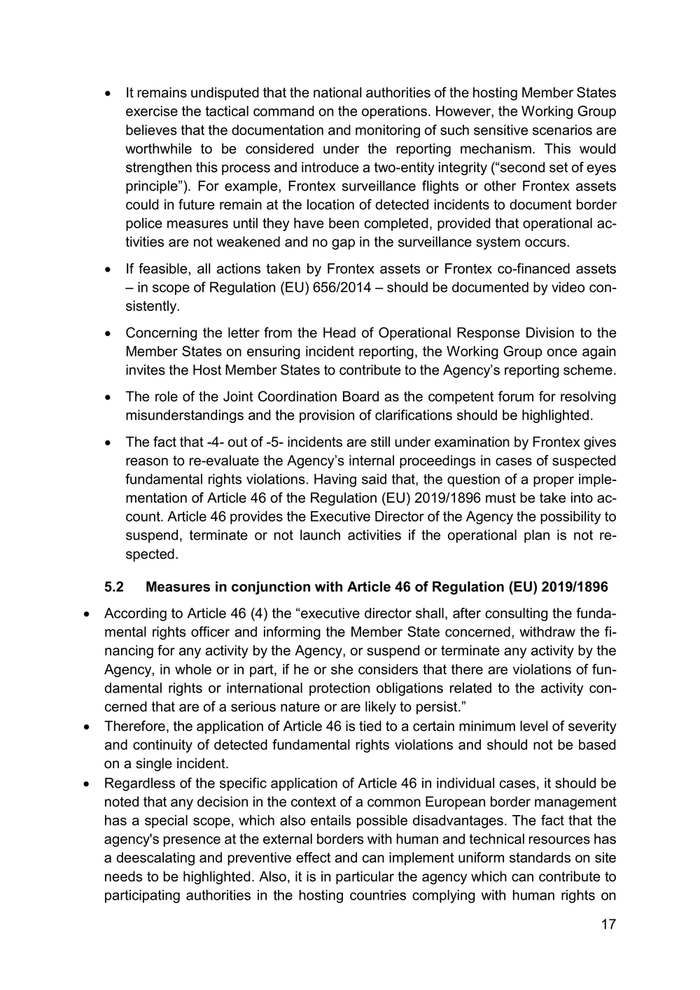
site and, in a certain way, embody a supervisory authority for entities and units involved. • Against this background, talking about considering the application of Article 46 in this particular case, -8- out of the -13- examined incidents were clarified and none of the incidents could substantiate fundamental rights violations. In relation to the remaining -5- incidents, it has to be stressed that only -1- incident has been closed by the Agency. For all other incidents, a final assessment is still pending for various reasons. Therefore, in view of the Working Group it can be said that, in view of all the circumstances, an application of Article 46 would not be justified in this case. • The existing legal framework only offers limited options for Frontex for action in the event of reported and established legal violations. The most important measure to name is the aforementioned examination of the applicability of Article 46. • Due to the seriousness and scope of such a decision, it would be necessary to discuss which measures below the threshold of Article 46 could be taken – in the sense of proportionality and Article 46 as a measure of last resort in the event of established legal violations. Such measures should be reflected in a tiered ap- proach with a set of proceedings, made applicable for the Agency’s operational activity. 18
